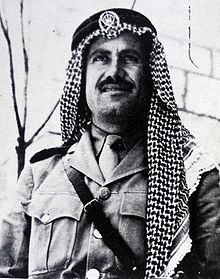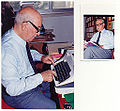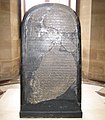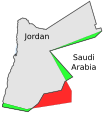
Back بوابة:الأردن Arabic دەروازە:ئوردن CKB Portail:Jordanie French Պորտալ:Հորդանան Armenian Portal:Jordan Malay Portal:Jordânia Portuguese Портал:Иордания Russian باب:اردن Urdu
The Jordan Portal  Jordan, officially the Hashemite Kingdom of Jordan, is a country in the Southern Levant region of West Asia. Jordan is bordered by Syria to the north, Iraq to the east, Saudi Arabia to the south, and Israel and the occupied Palestinian territories to the west. The Jordan River, flowing into the Dead Sea, is located along the country's western border within the Jordan Rift Valley. Jordan has a small coastline along the Red Sea in its southwest, separated by the Gulf of Aqaba from Egypt. Amman is the country's capital and largest city, as well as the most populous city in the Levant. Modern-day Jordan has been inhabited by humans since the Paleolithic period. Three kingdoms developed in Transjordan during the Iron Age: Ammon, Moab and Edom. In the third century BC, the Arab Nabataeans established their kingdom centred in Petra. The Greco-Roman period saw the establishment of several cities in Transjordan that comprised the Decapolis. Later, after the end of Byzantine rule, the region became part of the Islamic caliphates of the Rashidun, Umayyad, Abbasid, and the Ottoman. Following the 1916 Great Arab Revolt during World War I, former Ottoman Syria was partitioned, leading to the establishment of the Emirate of Transjordan in 1921, which became a British protectorate. In 1946, the country gained independence and became officially known as the Hashemite Kingdom of Jordan. The country captured and annexed the West Bank during the 1948 Palestine war until it was occupied by Israel in 1967. Jordan renounced its claim to the territory to the Palestinians in 1988 and signed a peace treaty with Israel in 1994. Jordan is a semi-arid country, covering an area of 89,342 km2 (34,495 sq mi) with a population of 11.5 million, making it the eleventh-most populous Arab country. The dominant majority, or around 95% of the country's population, is Sunni Muslim, with the rest being mostly Arab Christian. Jordan was mostly unscathed by the violence that swept the region following the Arab Spring in 2010. From as early as 1948, Jordan has accepted refugees from multiple neighbouring countries in conflict. An estimated 2.1 million Palestinian refugees, most of whom hold Jordanian citizenship, as well as 1.4 million Syrian refugees, were residing in Jordan as of 2015. The kingdom is also a refuge for thousands of Christian Iraqis fleeing persecution. While Jordan continues to accept refugees, the large Syrian influx during the 2010s has placed substantial strain on national resources and infrastructure. The sovereign state is a constitutional monarchy, but the king holds wide executive and legislative powers. Jordan is a founding member of the Arab League and the Organisation of Islamic Cooperation. The country has a high Human Development Index, ranking 99th, and is considered a lower middle income economy. The Jordanian economy, one of the smallest economies in the region, is attractive to foreign investors based upon a skilled workforce. The country is a major tourist destination, also attracting medical tourism with its well-developed health sector. Nonetheless, a lack of natural resources, large flow of refugees, and regional turmoil have hampered economic growth. (Full article...) Selected article -Black September (Arabic: أيلول الأسود Aylūl al-ʾAswad), also known as the Jordanian Civil War, was an armed conflict between Jordan, led by King Hussein, and the Palestine Liberation Organization (PLO), led by chairman Yasser Arafat. The main phase of the fighting took place between 16 and 27 September 1970, though certain aspects of the conflict continued until 17 July 1971. After the 1967 Six-Day War, Palestinian fedayeen guerrillas relocated to Jordan and stepped up their attacks against Israel and what had become the Israeli-occupied West Bank. They were headquartered at the Jordanian border town of Karameh, which Israel targeted during the Battle of Karameh in 1968, leading to a surge of Arab support for the fedayeen. The PLO's strength grew, and by early 1970, leftist groups within the PLO began calling for the overthrow of Jordan's Hashemite monarchy, leading to violent clashes in June 1970. Hussein hesitated to oust them from the country, but continued PLO activities in Jordan culminated in the Dawson's Field hijackings of 6 September 1970. This involved the Popular Front for the Liberation of Palestine (PFLP) seizing three civilian passenger flights and forcing their landing in the Jordanian city of Zarqa, where they took foreign nationals as hostages and blew up the planes in front of international press. Hussein saw this as the last straw and ordered the Jordanian Army to take action. (Full article...) Selected biography -Abdullah El Tell (Arabic: عبدالله التل, 17 July 1918 – 1973; his surname is also rendered Tal) was a Jordanian military officer. He served as the commander of the 6th regiment of Jordan's Arab Legion during the 1948 Arab-Israeli War, and was one of the main Jordanian military leaders in the Battle for Jerusalem as well as the West Bank front of the war. El Tell served as the military governor of the Old City of Jerusalem, a position he was appointed in during the 1948 War. He later fled into exile after he was accused of being a conspirator in the assassination of Jordan's king Abdullah I−which he vehemently denied−and spent many years in exile in Egypt before returning to Jordan in 1967. (Full article...) WikiProjectFor editor resources and to collaborate with other editors on improving Wikipedia's Jordan-related articles, see WikiProject Jordan. General images -The following are images from various Jordan-related articles on Wikipedia.
Selected city -Jerash (Arabic: جرش Ǧaraš; Greek: Γέρασα, romanized: Gérasa; Attic Greek: [gérasa], Koinē Greek: [ˈgerasa]) is a city in northern Jordan. The city is the administrative center of the Jerash Governorate, and has a population of 50,745 as of 2015. It is located 30.0 miles north of the capital city Amman. The earliest evidence of settlement in Jerash is in a Neolithic site known as Tal Abu Sowan, where rare human remains dating to around 7500 BC were uncovered. Jerash flourished during the Greek, Hellenistic, Roman, and Byzantine periods until the mid-eighth century AD, when the 749 Galilee earthquake destroyed large parts of it, while subsequent earthquakes contributed to additional destruction. However, in the year 1120, Zahir ad-Din Toghtekin, atabeg of Damascus ordered a garrison of forty men to build up a fort in an unknown site of the ruins of the ancient city, likely the highest spot of the city walls in the north-eastern hills. It was captured in 1121 by Baldwin II, King of Jerusalem, and utterly destroyed. Then, the Crusaders immediately abandoned Jerash and withdrew to Sakib (Seecip); the eastern border of the settlement. (Full article...)
See also: List of cities in Jordan
Related portalsReligions in Jordan Arab states Other countries Recognized content
Featured articlesGood articles
TopicsSelected topic overview -
CategoriesSelected picture - The Karak Castle (c. 12th century AD) built by the Crusaders, and later expanded under the Muslim Ayyubids and Mamluks.
Associated WikimediaThe following Wikimedia Foundation sister projects provide more on this subject:
SourcesDiscover Wikipedia using portals
|

































































